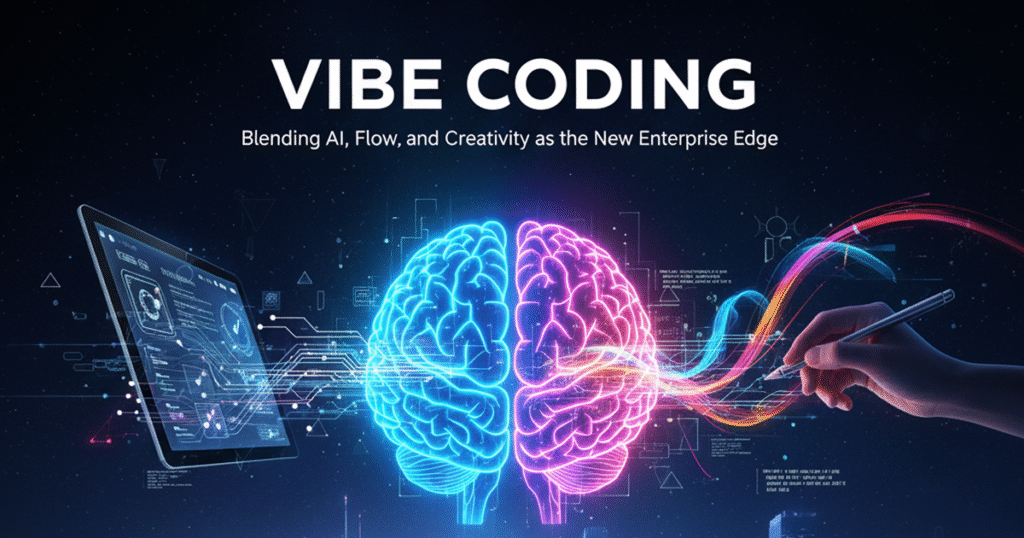In the last decade, enterprises have invested billions in digital transformation — cloud migrations, data platforms, automation, and modern app development. Yet, despite these advances, many organizations still feel slow. Business leaders ask: Why does it take weeks to launch a simple prototype? Why do development cycles remain rigid even with agile and DevOps?
The answer lies in the limits of traditional software development. Agile and DevOps improved delivery pipelines, but the process of writing code remained largely the same. Developers still translate requirements into thousands of lines of code, while non-technical teams wait on the sidelines.
In 2025, this paradigm is being reshaped by GenAI Solutions. By combining Vibe Coding, Generative AI Agents, and Creative AI Workflows, enterprises are unlocking a new edge — one that blends human creativity with AI speed to deliver innovation at a scale and pace never seen before.
What Is Vibe Coding?

Vibe Coding is the emerging practice of developing software in collaboration with AI. Instead of manually coding every component, teams describe intent in natural language prompts. AI then generates working code, which humans review, refine, and integrate.
For example:
1.A product manager types: “Build an approval workflow for vendor payments with notifications and audit logs.”
2.Generative AI Agents generate the codebase, integrate common APIs, and set up the workflow.
3.Developers validate architecture, run tests, and ensure compliance.
The name “vibe” reflects the flow state developers experience when they’re freed from repetitive tasks and can focus on design, problem-solving, and creativity.
Three key dimensions of Vibe Coding:
1.Automation of the routine
Boilerplate code, scaffolding, UI templates, and integrations handled by AI.
2.Developers as creative directors
Shifting from code-heavy tasks to architecture, optimization, and user experience design.
3.Democratization of participation
With Creative AI Workflows, non-technical stakeholders — product managers, designers, analysts — contribute directly, reducing misalignment.
Why Enterprises Are Paying Attention
1. Faster Prototyping and MVPs
With GenAI Solutions, MVPs can be built in days instead of weeks. For enterprises, this reduces the cost of experimentation. Teams can test multiple ideas before committing to one, saving time and investment.
📌 Case in Point: A global retail firm used Generative AI Agents to spin up a new customer rewards portal prototype in under two weeks. Traditionally, this would have taken two months. The prototype allowed real-time feedback from executives and customers, accelerating the final rollout.
2. Cross-Functional Collaboration
Vibe Coding lowers the technical barrier. Business and design teams can describe requirements directly in natural language. AI translates those into code, ensuring faster alignment.
📌 Scenario: A healthcare provider’s compliance team specifies a rule in plain English: “Flag all prescriptions above dosage X for manual review.” Within hours, the AI integrates it into the workflow system, with developers ensuring safeguards and auditability.
3. Developer Empowerment
Developers aren’t replaced — they are elevated. Instead of debugging boilerplate, they focus on innovation. They become creative directors of software: curating, refining, and ensuring that AI-generated outputs align with enterprise standards.
4. Cultural Competitiveness
Enterprises that embrace Creative AI Workflows foster a culture of innovation and flow. This not only improves productivity but also attracts and retains top talent. Developers increasingly seek environments where they can focus on problem-solving, not repetitive coding.
The Risks That Must Be Managed
Despite its promise, Vibe Coding is not without risks. Enterprises must balance speed with discipline.
Reliability and Maintainability
AI-generated code may be functional today but introduce hidden technical debt tomorrow. Without review, systems can become fragile.
Security and Compliance
Shadow coding, unvetted dependencies, or insecure defaults pose risks. Enterprises must ensure compliance with regulations such as GDPR, HIPAA, and SOC2.
📌 Example: An AI-generated integration accidentally exposed sensitive logs to public endpoints because security defaults were not configured. Without governance, such risks escalate quickly.
Debugging Complexity
Generative AI Agents don’t always explain their logic. Debugging failures can be time-consuming.
Trust and Oversight
Without governance, developers may hesitate to trust AI outputs, especially in mission-critical systems. This slows adoption and undermines potential benefits.
Guardrails for Enterprise Adoption
To make Vibe Coding enterprise-ready, leaders must adopt structured practices:
1.Governance Frameworks
Define where Vibe Coding applies (e.g., prototypes, internal tools) and where stricter rules apply (e.g., financial transactions, core systems).
2.Human-in-the-Loop
Code generated by AI must always pass through developer review, automated testing, and compliance checks.
3.Secure Development Pipelines
Integrate static analysis, vulnerability scans, and observability into CI/CD pipelines.
4.AI Literacy and Training
Equip teams to work effectively with Generative AI Agents. Training should cover prompt engineering, AI limitations, and risk identification.
5.Outcome-Based Metrics
Measure success using business KPIs: speed to market, defect rates, customer satisfaction, and cost efficiency.
Research and Market Insights
Academic studies (TU Delft, 2024) show that as GenAI embeds into development, creativity will be the differentiator. Efficiency alone is not enough.
Qualitative research (2025) reveals that developers using Vibe Coding experience joy, creativity, and flow, but struggle with trust, debugging, and unclear specs.
McKinsey (2025) reports that enterprises leveraging GenAI Solutions see faster time-to-market, but only when paired with governance and metrics.
The Future Outlook
AI as Teammate, Not Tool
Generative AI Agents will become autonomous teammates in development, handling entire workflows end-to-end with humans providing oversight.
Democratization of Development
Creative AI Workflows will enable business users to directly influence prototypes. Software creation will no longer be confined to IT.
Developers as Orchestrators
The developer role evolves into orchestrators of AI outputs, ensuring compliance, performance, and innovation.
Competitive Advantage
The ultimate differentiator will be the ability to blend GenAI Solutions with enterprise-grade discipline — those who master this will lead their industries.
The Brigita.co Perspective
At Brigita.co, we believe that GenAI is not just a technology shift — it is a mindset transformation. Vibe Coding represents the fusion of AI speed, human creativity, and disciplined governance. Enterprises that embrace this shift responsibly will:
1.Accelerate innovation cycles
2.Empower teams across functions
3.Build cultures that attract top talent
4.Differentiate through speed, creativity, and resilience
The future belongs to enterprises that reimagine how they build and innovate, not just those that adopt the latest tools.
Frequently Asked Questions
Q1: What does Brigita mean?
A: Brigita means a global technology consulting and software development company delivering AI, cloud, and SaaS solutions. We help enterprises worldwide—including India, UAE, Dubai, GCC, and the USA—adopt Vibe Coding and AI-driven development for faster, scalable, and innovative software solutions.
Q2: What is Vibe Coding in enterprise software?
A: Vibe Coding is an AI-augmented development approach where developers and non-technical stakeholders collaborate using AI to generate code, scaffolds, and prototypes. Brigita implements Vibe Coding globally to accelerate enterprise software delivery across India, UAE, Dubai, GCC, and the USA.
Q3: How does AI improve software development with Vibe Coding?
A: AI accelerates coding, reduces manual boilerplate, and helps teams focus on architecture, UX, and creative problem-solving. Brigita integrates AI-driven workflows for enterprises in India, UAE, Dubai, GCC, and the USA, boosting productivity and innovation.
Q4: What are the benefits of AI-powered Vibe Coding for businesses?
A: AI-powered Vibe Coding enables faster prototyping, collaborative development, and cost efficiency. Brigita helps enterprises worldwide—including India, UAE, Dubai, GCC, and the USA—leverage AI to build scalable, secure, and user-friendly applications.
Q5: Why choose Brigita for implementing Vibe Coding?
A: Brigita combines AI, human creativity, and enterprise-grade software practices to deliver innovative solutions. Our services span India, UAE, Dubai, GCC, and the USA, helping enterprises adopt Vibe Coding for efficient, compliant, and high-quality software development.
Search
Categories

Author
-
Keerthi Kumar A V is a backend developer in the early stages of his career, working with Django, Flutter, and interactive dashboards. Though new to the professional world, he is actively exploring vibe coding, AI-driven projects, and contributing to a solutions team. Curious and driven, Keerthi enjoys experimenting with coding projects, learning new technologies, and applying practical problem-solving to real-world challenges. He combines his passion for continuous learning with hands-on development, treating each project as an opportunity to grow and refine his skills.
